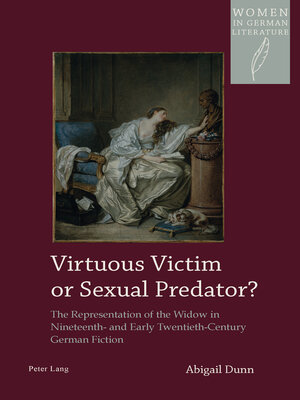Virtuous Victim or Sexual Predator?
ebook ∣ The Representation of the Widow in Nineteenth- and Early Twentieth-Century German Fiction · Women, Gender and Sexuality In German Literature and Culture
By Helen Watanabe-O'Kelly

Sign up to save your library
With an OverDrive account, you can save your favorite libraries for at-a-glance information about availability. Find out more about OverDrive accounts.
Find this title in Libby, the library reading app by OverDrive.



Search for a digital library with this title
Title found at these libraries:
| Library Name | Distance |
|---|---|
| Loading... |
'Was ist eine Witwe mehr als ... ein aufgewärmtes Essen?'
According to politician and statesman Theodor Gottlieb von Hippel (1741-1796), widows were superfluous beings and second-hand goods, but they were also perceived by theologians and moralists of the nineteenth and early twentieth centuries as a threat due to their sexual experience and supposedly ungovernable lust.
This book analyses the overwhelmingly negative portrayal of the widow in nineteenth- and early twentieth-century German fiction. Male writers in the works discussed repeat the theory that, once deprived of their husbands, widows become sexually voracious. Indeed, the widow is often presented as a dangerous sexual predator who is prone to violence. Female authors, however, highlight the invisibility of the widow and portray her as a figure alienated from society and her family because she has internalized the ideas propounded by Hippel. The widow is depicted throughout as a figure to be at best re-educated and at worst to be feared and guarded against.
According to politician and statesman Theodor Gottlieb von Hippel (1741-1796), widows were superfluous beings and second-hand goods, but they were also perceived by theologians and moralists of the nineteenth and early twentieth centuries as a threat due to their sexual experience and supposedly ungovernable lust.
This book analyses the overwhelmingly negative portrayal of the widow in nineteenth- and early twentieth-century German fiction. Male writers in the works discussed repeat the theory that, once deprived of their husbands, widows become sexually voracious. Indeed, the widow is often presented as a dangerous sexual predator who is prone to violence. Female authors, however, highlight the invisibility of the widow and portray her as a figure alienated from society and her family because she has internalized the ideas propounded by Hippel. The widow is depicted throughout as a figure to be at best re-educated and at worst to be feared and guarded against.







